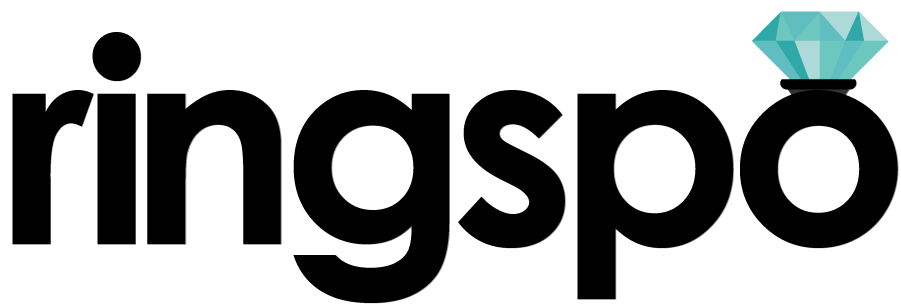Sell Your Diamond Bracelet
Understand Where To Sell Your Diamond Bracelet To Get The Best Price

By Alastair Smith · Updated: June 13th 2023
Currently looking to sell a diamond bracelet but want to make sure you get the best price for it?
Of course you do.

Ringspo is reader supported
Ringspo is reader-supported, which means we may receive a commission if you click a link to a retailer & subsequently make a purchase.
We feature links to several retailers to help readers find the one that is the best fit for them. Find out more about how Ringspo works here.
Three things to know if you are looking to sell your diamond bracelet
- Selling a diamond bracelet is like selling a second-hand car – you won’t get the ‘list price’ ie. the appraisal value
- There’s a while host of factors that will affect how much you will receive – total carat weight of the diamonds, the quality of the diamonds, brand name, condition and the market demand at they time you’re selling.
- Finding the right buyer is key to get the most money possible. We recommend Worthy as they will get your bracelet out in front of as many potential buyers as possible, which can increase you sale price.
Why Your Receipt or Appraisal Isn’t the Best Indicator of What Your Diamond Bracelet is Actually Worth:
First-off, we’re going to get this slightly awkward bit out of the way.
While you may have the original purchase receipt or an appraisal for your diamond bracelet that has a price or a valuation on it, they almost certainly don’t reflect the current market value of your bracelet when it comes to selling it.
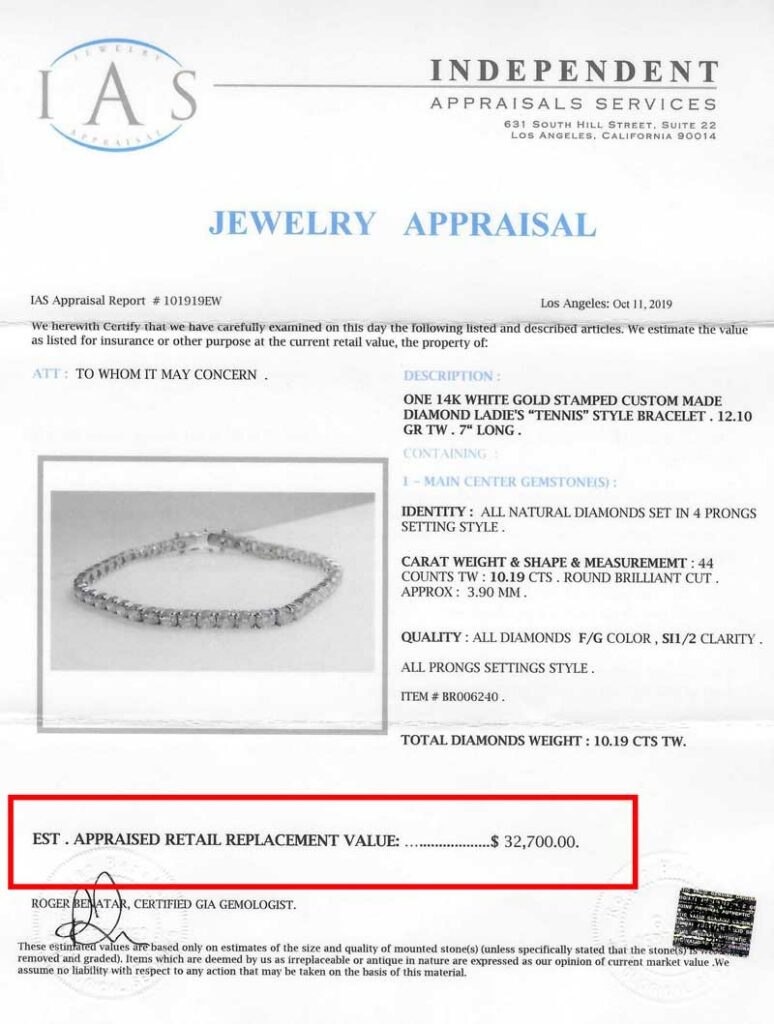
The reason for this is that anyone who is going to buy your bracelt will be looking to sell it for a price that is appropriate for a pre-owned piece of jewelry. Plus, they need to cover their own costs and build in some profit margin for themselves.
What appraisals or a receipt are useful for:
Both a purchase receipt and an appraisal should contain essential information about your bracelet such as its total carat weight, the color, clarity, cut or the diamonds and the type and quality of the metal in the bracelet itself.
This is all essential information that you’ll need when selling as it will allow potential buyers to understand what you have.
Factors That Affect the Value of a Diamond Bracelet
When we talk about the value of a diamond bracelet, we’re really talking about how much someone would be willing to pay for it.
It’s important to understand the various factors that influence that value – this will help ensure you receive a fair and accurate appraisal and subsequently, the best price possible when selling your bracelet.
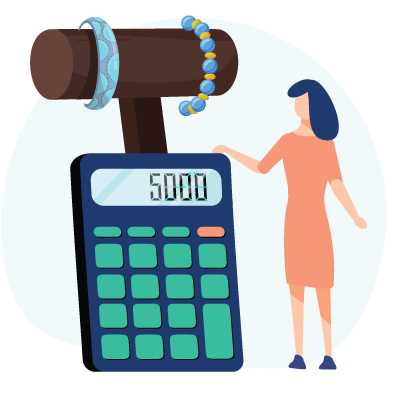
The Quality of the Diamonds
At the forefront of these factors lies the quality of the diamonds themselves. It’s not just about the quantity of diamonds on the bracelet but the quality of each diamond that really counts. The quality essentially dictates the beauty, rarity, and desirability of the diamonds, all of which translate to their market value.
Diamond quality is commonly assessed by the 4Cs: cut, color, clarity, and carat weight. Established by the Gemological Institute of America (GIA), the 4Cs are the universal method for assessing the quality of any diamond, anywhere in the world.
Let’s break down how each of these 4Cs influences the value of your diamond bracelet:
- Cut: The cut of a diamond determines how well it sparkles. A well-cut diamond reflects light to its maximum ability, making it look larger and more brilliant. A poorly cut diamond, however, may appear dull and smaller than its actual size, thereby reducing the overall appeal and value of your diamond bracelet.
- Color: Diamond color is assessed based on the absence of color, where a perfect diamond would be completely colorless. The GIA grades diamond color on a scale from D (colorless) to Z (light yellow or brown). A colorless diamond, which falls in the D-F range, will be more valuable than a diamond that shows noticeable color, like those in the S-Z range.
- Clarity: The clarity of a diamond refers to the absence of inclusions and blemishes. Flawless diamonds, without any internal or external imperfections, are incredibly rare and consequently, more expensive. In contrast, a diamond with visible inclusions may lower the overall value of your diamond bracelet.
The Total Carat Weight of the Diamonds
Carat weight measures the size of the diamond – larger diamonds are generally more valuable as they are rarer. However, the value doesn’t rise proportionally with the weight, as the other three Cs significantly influence a diamond’s overall quality and cost.
With diamond bracelets, the important factor is the total carat weight of all the diamonds combined. This figure essentially encapsulates the size and weight of all the diamonds on your bracelet, providing a collective measurement rather than individual diamond weights.
The total carat weight is calculated by adding up the carat weight of each individual diamond in the bracelet. So, if you have a bracelet with ten 0.1-carat diamonds, your total carat weight would be 1 carat. Total carat weight is why if you’re selling a diamond necklace, it will typically be more valuable than a bracelet – there are just more diamonds.
Generally speaking, a higher total carat weight can increase the value of your diamond bracelet. However, this increase isn’t always proportional. For instance, a bracelet with a lower total carat weight but with diamonds of exceptional quality (based on the 4Cs) may still fetch a high price due to the rarity and desirability of high-quality diamonds.
The Type and Quality of the Metal
The value of a diamond bracelet isn’t solely determined by the diamonds themselves. The type and quality of the metal also play a significant role in influencing its overall worth. The metal affects the bracelet’s durability, appearance, and cost.
The type and quality of the metal are largely determined by its purity, alloy (the mixture of metals), and finish. For instance, gold purity is measured in karats, with 24-karat gold being pure gold. However, pure gold is too soft for everyday wear, so it’s often mixed with other metals to enhance durability. This alloy process can also alter the color of the gold, leading to variations like white gold and rose gold.
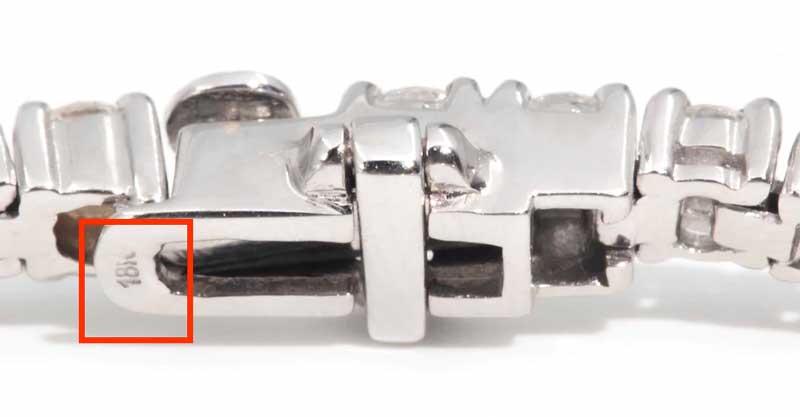
Here’s how different metals can impact the value of your diamond bracelet:
- Platinum is more valuable than gold or silver due to its rarity, durability, and hypoallergenic properties. Its silvery-white appearance also offers a sleek and modern aesthetic that pairs beautifully with diamonds.
- Gold values of gold can vary significantly depending on its karat (purity), color (alloy), and polish (finish). For instance, a diamond bracelet made from 18-karat gold will be more valuable than one made from 14-karat gold due to the higher gold content.
- While silver can provide a lovely setting for diamonds, it’s generally less valuable than gold or platinum. This is largely because silver is more abundant, softer, and more prone to tarnishing. However, a well-crafted and well-maintained silver diamond bracelet can still hold considerable value.
Understanding the value of the metal in your diamond bracelet can give you a more complete picture of its overall value and help you set realistic expectations when you decide to sell it.
The Brand or Designer Name
The name associated with your diamond bracelet can also heavily influence its value. This could be the name of a renowned jewelry brand or a respected designer. Brands or designers with a reputation for prestige, quality, and exceptional craftsmanship tend to command higher prices.
In the jewelry industry, certain brands and designers have carved out a name for themselves and are more sought-after than others. For instance, pieces from luxury brands such as Tiffany & Co., Bvlgari, Cartier, and Harry Winston carry a certain cachet due to their reputation for high-quality materials, exquisite designs, and impeccable service.
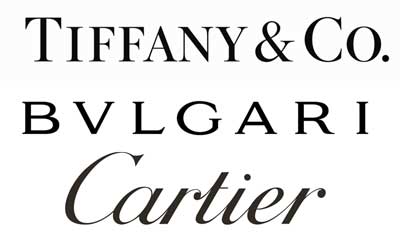
Bracelets from these high-end brands can fetch premium prices due to their association with luxury, quality, and desirability. Therefore, if your diamond bracelet has been created by one of these prestigious names, you could potentially secure a higher selling price.
The Condition and Style of the Bracelet
Lastly, the condition and style of your diamond bracelet significantly impact its value. These factors essentially reflect how well-maintained, appealing, and up-to-date your piece is.
Bracelets that show signs of wear and tear, damage, or previous repairs might fetch lower prices. Similarly, pieces that follow outdated or unpopular style trends may see reduced demand, thus negatively affecting their resale value.

However, you can take steps to improve the condition and style of your bracelet before selling. For instance, consider getting your bracelet professionally cleaned and polished to restore its shine and newness.

If your piece has sustained damage or defects, a professional jeweler might be able to repair it, enhancing its appearance and functionality.
Best Place to Sell a Diamond Bracelet
When you’re selling a diamond bracelet, it can be tempting to go for a quick, easy sale. However, doing do can mean that you receive significantly less than you should.
If you’re in a hurry to sell and simply Google ‘diamond bracelet buyers near me’ and then choose the first on the list, it’s likely that you will receive significantly less for your diamond than you should.

When it comes to selling a diamond bracelet, there are several options available to consider.
Each option has its own advantages and considerations. Let’s explore the different selling avenues and break down the pros and cons of each:
Selling a diamond bracelet through general online marketplaces like eBay, Craigslist, or Facebook Marketplace
Online marketplaces offer convenience and access to a wide customer base. You can quickly list items and either reach thousands of local buyers or even millions of potential buyers worldwide.
Despite the convenience and wide audience reach, there are also challenges with selling on general online marketplaces. Firstly, the competition is high, with many similar items listed for sale.
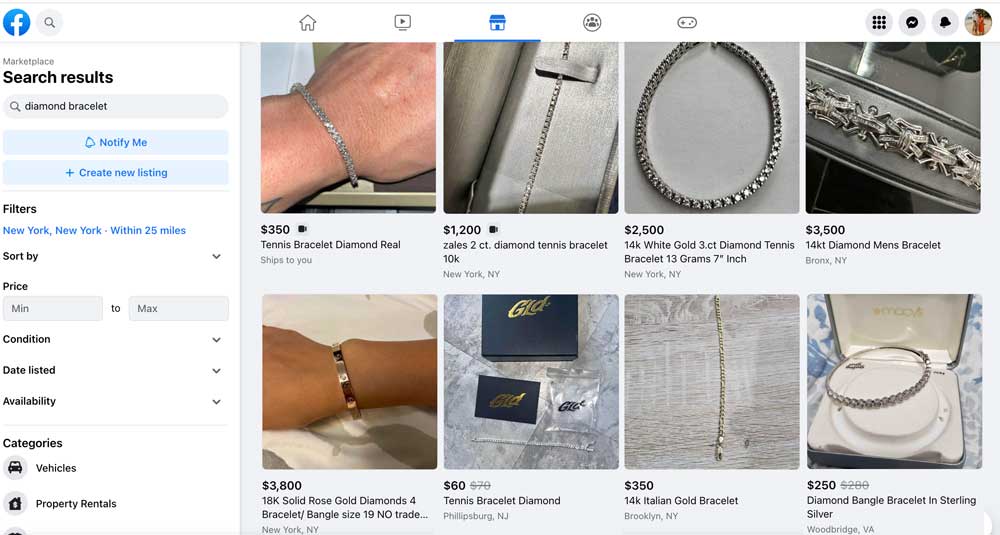
This can lead to lower selling prices unless the item is particularly unique or high quality. Secondly, these platforms often charge listing and selling fees, which can eat into the final selling price. Lastly, selling valuable items like diamond bracelets can attract fraudulent buyers, so it’s crucial to be aware of the platform’s policies for seller protection.
Nevertheless, for those willing to navigate these challenges, general online marketplaces offer a flexible and readily available option for selling a diamond bracelet.
Jewelry-Specific Online Marketplaces
Jewelry-specific online marketplaces like worthy.com offer a targeted audience interested in purchasing fine jewelry. These platforms are designed specifically for the buying and selling of high-quality jewelry, and as such, they cater to an audience with a keen interest and understanding of the value of such items. This can often result in better pricing compared to general marketplaces.
When using a jewelry-specific online marketplace, the process is typically more curated and supportive. Many of these platforms offer services like professional photography, expert descriptions, and detailed appraisals, which can enhance the listing and attract serious buyers. The detailed evaluation can also give potential buyers confidence in the quality and authenticity of the bracelet, which can lead to higher bids.
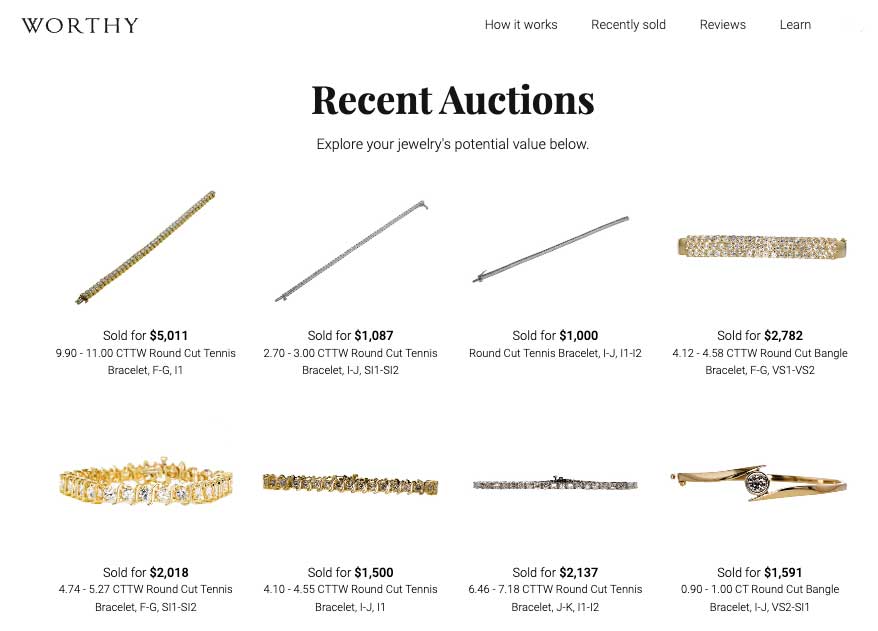
In contrast to general online marketplaces, these platforms often handle much of the sales process, including secure shipping, insurance, and direct communication with buyers. This can make the selling process smoother and less time-consuming for the seller.
However, it’s worth noting that these specialized services often come with higher fees compared to general online marketplaces. While these costs may be offset by achieving a higher selling price, it’s an important factor to consider.
Selling a diamond bracelet through Auction Houses:
Auction houses, both physical and online, are traditional venues where diamond bracelets can be sold through competitive bidding. This option can attract serious buyers, including collectors, jewelry enthusiasts, and even industry professionals, and can potentially drive up the selling price.
One of the key advantages of selling through an auction house is the professional expertise that these establishments provide. Auction houses have experts on staff who can accurately assess the value of your diamond bracelet based on its quality, brand, condition, and current market trends. This expertise ensures that the bracelet is priced appropriately and can help attract the right buyers.
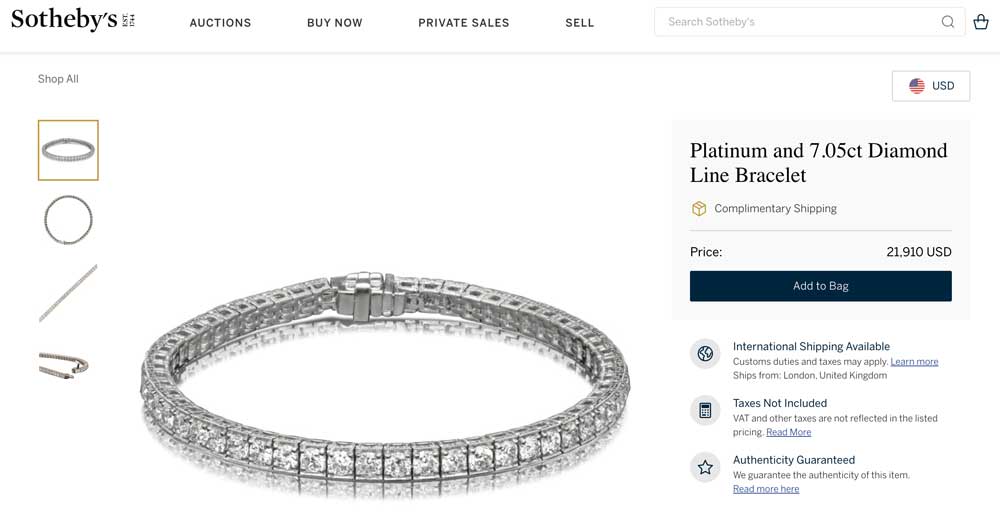
Furthermore, auction houses often have a reputation for dealing in high-quality and valuable items, which can help attract a more affluent and serious audience compared to general or jewelry-specific online marketplaces. This can create a competitive bidding environment, which has the potential to increase the final sale price.
However, selling through an auction house also has its challenges. For instance, the process can be slower than other methods, as auctions are typically scheduled events and there may be a waiting period before your bracelet can be included in an auction.
Fees can also be a consideration, as auction houses generally charge a commission on the sale price. Some may also charge additional fees for services like insurance, storage, and photography. It’s important to understand these costs upfront.
Lastly, while the competitive nature of an auction can drive up prices, there’s also a risk that the item may sell for less than expected if there’s low interest or competition on the day of the auction.
Local Jewelry Stores:
Selling your diamond bracelet to a local jewelry store can offer convenience and the opportunity to work with professionals who specialize in diamonds and jewelry. These stores are typically staffed with knowledgeable individuals who can provide a fair assessment of your bracelet’s worth.
One of the main advantages of selling to a local jewelry store is the personal interaction it allows. Sellers can speak directly with jewelry professionals, ask questions, and even negotiate the price. This is a stark contrast to online platforms where most communication is done virtually, often without the chance for real-time negotiation or discussion.
Additionally, selling to a local jewelry store typically means a quicker sales process. Unlike online marketplaces or auction houses, there’s no need to wait for a buyer. If the store is interested, they will usually make an offer on the spot, resulting in immediate payment. This can be particularly advantageous for those looking to sell their bracelet quickly.
However, there are also some potential downsides to consider. Local jewelry stores, especially those that buy and sell pre-owned jewelry, are in the business of making a profit. Therefore, they need to buy at a price that allows them to resell at a profit. This means that the offer you receive may be lower than what you could potentially get from a private buyer.
Furthermore, the market for your particular bracelet may be smaller. Unlike online platforms that can reach a global audience, local jewelry stores are limited to their local customer base. If your bracelet is a niche or high-end piece, it may be harder to find a buyer willing to pay a premium price.
Diamond and Jewelry Buyers:
Specialized diamond and jewelry buyers focus on purchasing pre-owned diamond jewelry directly from sellers. These professionals, often gemologists or individuals with a deep understanding of the diamond and jewelry market, offer a dedicated service designed to provide fair value for your items.
Selling a diamond bracelet to a specialized buyer has the advantage of their expert knowledge in the field. They can accurately evaluate the quality of your bracelet and price it based on the current market. In addition, many diamond and jewelry buyers offer a quick and straightforward process, often providing an offer after an initial assessment.
Another key benefit is that these buyers are often interested in a wide range of items, from branded high-end pieces to more common diamond bracelets, a well as other jewelry like diamond earrings. This could potentially make it easier to find a buyer for your specific item, even if it’s more niche or unique.
Moreover, similar to local jewelry stores, transactions with specialized diamond and jewelry buyers are typically secure and immediate, avoiding the risks associated with shipping valuable items or dealing with fraudulent online buyers. They also often handle the logistics of the transaction, simplifying the process for the seller.
However, as with local jewelry stores, the offers made by specialized buyers are often lower than what you might receive from a private buyer in a competitive marketplace. This is because these buyers need to consider their profit margins and the potential risks and costs associated with reselling the item.
In some cases, diamond and jewelry buyers may not have a physical storefront, operating primarily online or through private appointments. This means that sellers may need to ship their items for evaluation, which can introduce risks and costs, although many reputable buyers offer insured shipping options.
When selling a diamond bracelet, it’s crucial to carefully evaluate the pros and cons of each option based on your priorities, timeline, and desired selling price.
Think about factors such as convenience, potential selling price, market exposure, and level of control you have over the process.
Additionally, conducting research, seeking multiple opinions, and verifying the reputation and legitimacy of potential buyers or platforms can help ensure you get the result you want.
How to Avoid Common Mistakes When Selling Your Diamond Bracelet
Maximizing profit and minimizing risk when selling your diamond bracelet is crucial. To help, here are five common mistakes people make when selling their diamond bracelet and how to avoid them.
Mistake #1: Selling Your Diamond Bracelet Without Knowing Its Value
Selling your bracelet without a clear understanding of its value is a sure way to be underpaid. By doing your homework and researching the value of your bracelet before selling it, you can set realistic expectations and identify fair offers when they come along.
Mistake 2: Not Preparing Your Diamond Bracelet For Sale
A bracelet in poor condition may lower its value and turn off potential buyers.
Before selling, take time to clean and polish your bracelet and, if possible, repair any damage. This simple step can significantly increase the appeal of your jewelry and its overall value.
Mistake #3: Selling Your Diamond Bracelet to the First Buyer You Find
While it might be tempting to accept the first offer, you could miss out on better deals. By shopping around and comparing different offers, you’ll be in a better position to make an informed decision and maximize your profits.
Mistake #4: Selling Your Diamond Bracelet Without Verifying the Buyer or Seller
With the risk of scams and frauds, verifying the reputation of your buyer or seller is critical. Check online reviews, ratings, and their business practices. The extra time spent could save you from significant loss.
Mistake #5: Selling Your Diamond Bracelet Without Getting a Receipt or Contract
Always get a written receipt or contract detailing the terms of the sale. This document serves as proof of the transaction and can help avoid legal or financial issues later on.
Selling a diamond bracelet can be a rewarding experience if done right. With research, preparation, and an understanding of your bracelet’s value, you can ensure you’re getting the best price. Avoiding common mistakes can further protect you from potential pitfalls.
Summing Up: Our Recommendation on Where to Sell Your Diamond Bracelet
Before selling, conduct thorough research and compare prices from different sources. Have your bracelet appraised and certified by a reputable gemologist or laboratory. This step verifies the authenticity and quality of your gemstone, providing confidence to potential buyers.
Select the selling option that aligns with your goals, preferences, and situation. Carefully weigh the pros and cons of each option and negotiate for the best deal possible.
Be realistic and flexible in your expectations and demands. Understand that the market value of your bracelet may not match your sentimental value or personal preference.
Worthy.com: The Best Way To Sell A Diamond Bracelet For Most People
Worthy is an auction site that gets your braclet jewelry out in front of hundreds of jewelry buyers to bid on.
This scale means that higher sales prices can be achieved, but Worthy’s commissions do need to be take into account when calculating how much you will actually receive into your pocket.
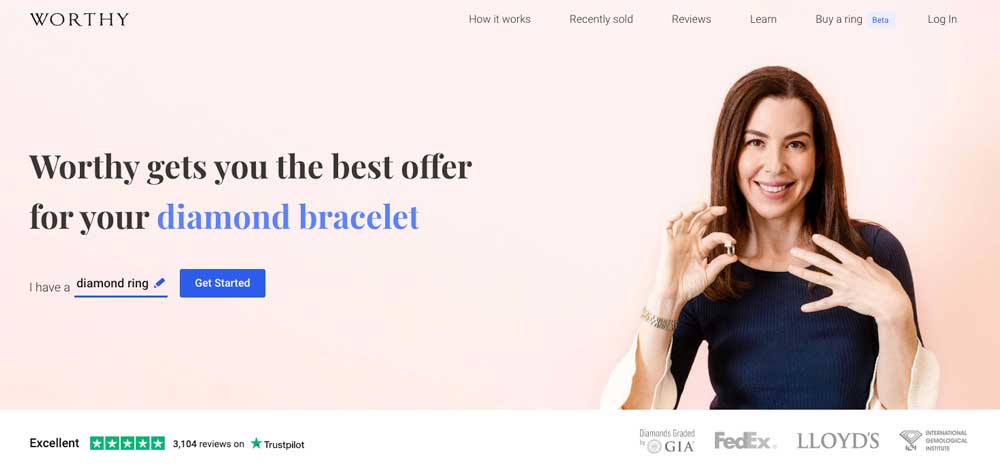
And again, if you haven’t checked it out, the ‘recent auctions‘ page is definitely worth checking out.
